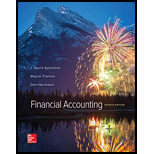
Financial Accounting
4th Edition
ISBN: 9781259307959
Author: J. David Spiceland, Wayne M Thomas, Don Herrmann
Publisher: McGraw-Hill Education
expand_more
expand_more
format_list_bulleted
Question
Chapter 6, Problem 6.3BP
1.
To determine
To record: The transactions of the Company CD for the month of June using perpetual inventory system.
2.
To determine
To prepare: The top section of the multi-step income statement through gross profit for the month of June.
Expert Solution & Answer
Want to see the full answer?
Check out a sample textbook solution
Students have asked these similar questions
General accounting
Please give me answer general accounting question
What would be the cost per unit?
Chapter 6 Solutions
Financial Accounting
Ch. 6 - 1.What is inventory? Where in the financial...Ch. 6 - Prob. 2RQCh. 6 - What is the difference among raw materials...Ch. 6 - Prob. 4RQCh. 6 - Prob. 5RQCh. 6 - What is a multiple-step income statement? What...Ch. 6 - Cheryl believes that companies report cost of...Ch. 6 - What are the three primary cost flow assumptions?...Ch. 6 - 9.Which cost flow assumption generally results in...Ch. 6 - Prob. 10RQ
Ch. 6 - Prob. 11RQCh. 6 - 12.Explain how LIFO generally results in lower...Ch. 6 - Prob. 13RQCh. 6 - Explain how freight charges, purchase returns, and...Ch. 6 - Explain the method of reporting inventory at lower...Ch. 6 - 16.How is cost of inventory determined? How is net...Ch. 6 - 17.Describe the entry to adjust from cost to net...Ch. 6 - Prob. 18RQCh. 6 - Prob. 19RQCh. 6 - How is gross profit calculated? What is the gross...Ch. 6 - 21.Explain how the sale of inventory on account is...Ch. 6 - Prob. 22RQCh. 6 - Prob. 23RQCh. 6 - Prob. 24RQCh. 6 - Understand terms related to types of companies...Ch. 6 - Prob. 6.2BECh. 6 - Calculate cost of goods sold (LO62) At the...Ch. 6 - Prob. 6.4BECh. 6 - Calculate ending inventory and cost of goods sold...Ch. 6 - Calculate ending inventory and cost of goods sold...Ch. 6 - Calculate ending inventory and cost of goods sold...Ch. 6 - Prob. 6.8BECh. 6 - Identify financial statement effects of FIFO and...Ch. 6 - Prob. 6.10BECh. 6 - Record freight charges for inventory using a...Ch. 6 - Record purchase returns of inventory using a...Ch. 6 - Prob. 6.13BECh. 6 - Prob. 6.14BECh. 6 - Prob. 6.15BECh. 6 - Prob. 6.16BECh. 6 - Prob. 6.17BECh. 6 - Prob. 6.18BECh. 6 - Record purchase returns of inventory using a...Ch. 6 - Refer to the information in BE613, but now assume...Ch. 6 - Prob. 6.21BECh. 6 - Prob. 6.22BECh. 6 - Calculate cost of goods sold (LO62) Russell Retail...Ch. 6 - Prob. 6.2ECh. 6 - Prob. 6.3ECh. 6 - Calculate inventory amounts when costs are rising...Ch. 6 - Calculate inventory amounts when costs are...Ch. 6 - Record Inventory transactions using o perpetual...Ch. 6 - Record inventory purchase and purchase return...Ch. 6 - Prob. 6.8ECh. 6 - Prob. 6.9ECh. 6 - Prob. 6.10ECh. 6 - Record transactions using a perpetual system...Ch. 6 - Record transactions using a perpetual system...Ch. 6 - Calculate inventory using lower of cost and net...Ch. 6 - Prob. 6.14ECh. 6 - Calculate cost of goods sold, the inventory...Ch. 6 - Prob. 6.16ECh. 6 - Prob. 6.17ECh. 6 - Prob. 6.18ECh. 6 - Record inventory purchases and sales using a...Ch. 6 - Mulligan Corporation purchases inventory on...Ch. 6 - Complete the accounting cycle using Inventory...Ch. 6 - Calculate ending inventory and cost of goods sold...Ch. 6 - Prob. 6.2APCh. 6 - Prob. 6.3APCh. 6 - Prob. 6.4APCh. 6 - Calculate ending inventory end cost of goods sold...Ch. 6 - Record transactions using a perpetual system,...Ch. 6 - Prob. 6.7APCh. 6 - Prob. 6.8APCh. 6 - Record transactions and prepare a partial income...Ch. 6 - Prob. 6.10APCh. 6 - Calculate ending inventory and cost of goods sold...Ch. 6 - Prob. 6.2BPCh. 6 - Prob. 6.3BPCh. 6 - Prob. 6.4BPCh. 6 - Prob. 6.5BPCh. 6 - Record transactions using a perpetual system,...Ch. 6 - Prob. 6.7BPCh. 6 - Use the inventory turnover retio end gross profit...Ch. 6 - Record transactions and prepare a partial income...Ch. 6 - Determine the effects of inventory errors using...Ch. 6 - Great Adventures (This is a continuation of the...Ch. 6 - Prob. 6.2APFACh. 6 - Prob. 6.3APFACh. 6 - Comparative Analysis American Eagle Outfitters,...Ch. 6 - Prob. 6.5APECh. 6 - Prob. 6.6APIRCh. 6 - Written Communication You have just been hired as...Ch. 6 - Prob. 6.8APEM
Knowledge Booster
Learn more about
Need a deep-dive on the concept behind this application? Look no further. Learn more about this topic, accounting and related others by exploring similar questions and additional content below.Similar questions
arrow_back_ios
SEE MORE QUESTIONS
arrow_forward_ios
Recommended textbooks for you
 Financial And Managerial AccountingAccountingISBN:9781337902663Author:WARREN, Carl S.Publisher:Cengage Learning,
Financial And Managerial AccountingAccountingISBN:9781337902663Author:WARREN, Carl S.Publisher:Cengage Learning,

Financial And Managerial Accounting
Accounting
ISBN:9781337902663
Author:WARREN, Carl S.
Publisher:Cengage Learning,
IAS 29 Financial Reporting in Hyperinflationary Economies: Summary 2021; Author: Silvia of CPDbox;https://www.youtube.com/watch?v=55luVuTYLY8;License: Standard Youtube License